音标认读(完全版)
- 格式:doc
- 大小:96.00 KB
- 文档页数:10
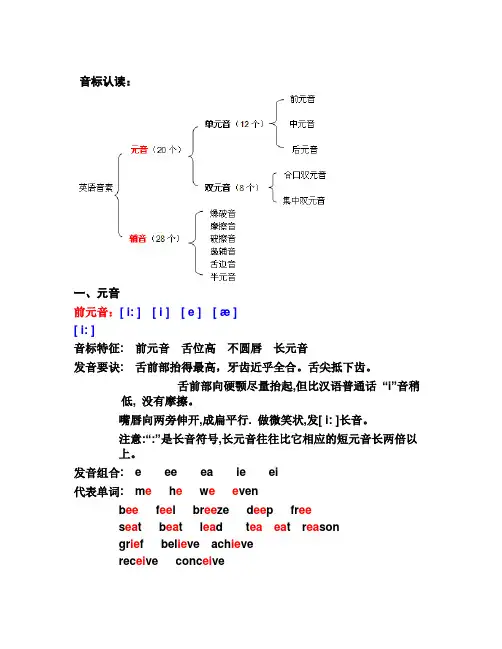
音标认读:一、元音前元音:[ i: ] [ i ] [ e ] [ æ ][ i: ]音标特征: 前元音舌位高不圆唇长元音发音要诀: 舌前部抬得最高,牙齿近乎全合。
舌尖抵下齿。
舌前部向硬颚尽量抬起,但比汉语普通话“i”音稍低, 没有摩擦。
嘴唇向两旁伸开,成扁平行. 做微笑状,发[ i: ]长音。
注意:“:”是长音符号,长元音往往比它相应的短元音长两倍以上。
发音组合: e ee ea ie ei代表单词: m e h e w e e venb ee f ee l br ee ze d ee p fr ees ea t b ea t l ea d t ea ea t r ea songr ie f bel ie ve ach ie verec ei ve conc ei ve[ i ]音标特征: 前元音半高音扁平唇短元音发音要诀: 舌前部比[i:]稍低,比[e]高,舌尖抵下齿,嘴唇扁平分开。
牙床也开得稍大一些比[ i:]稍宽,比[ e ]窄。
上下齿之间的距离大约可以容纳一个小指尖。
使下颚稍稍下垂,舌前部也随之稍稍下降,即可发出短促[ i ]音。
发音组合: i代表单词: s i t b i t k i ck p i ck w i sh音标对比: [ i: ] [ i ]s ea t s i tb ea t b i tsh ee p sh i p[ e ]音标特征:前元音半高音不圆唇短元音发音要诀:舌尖抵下齿, 舌前部稍抬起, 舌后接近硬颚, 比[ i:] 低。
牙床也开得半开半合,比[ i:] 宽,整体做微笑状。
上下齿之间的距离大约相当于一个食指尖。
发音组合: e ea a代表单词:p e n t e n b e st b e g e gg n e tbr ea d h ea venm a rry a ny m a ny音标对比:[ i ] [ e ]s i t s e tl i ft l e ftd i d d ea d[æ]音标特征: 前元音低舌音不圆唇短元音发音要诀: 舌前部最低,双唇向两旁平伸,成扁平行牙床开的最大。
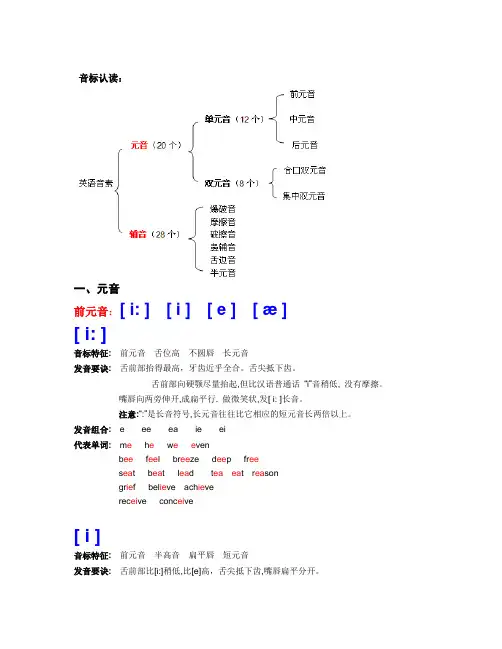
音标认读:一、元音前元音:[ i: ] [ i ] [ e ] [ æ ][ i: ]音标特征:前元音舌位高不圆唇长元音发音要诀:舌前部抬得最高,牙齿近乎全合。
舌尖抵下齿。
舌前部向硬颚尽量抬起,但比汉语普通话“i”音稍低, 没有摩擦。
嘴唇向两旁伸开,成扁平行. 做微笑状,发[ i: ]长音。
注意:“:”是长音符号,长元音往往比它相应的短元音长两倍以上。
发音组合: e ee ea ie ei代表单词:m e h e w e e venb ee f ee l br ee ze d ee p fr ees ea t b ea t l ea d t ea ea t r ea songr ie f bel ie ve ach ie verec ei ve conc ei ve[ i ]音标特征: 前元音半高音扁平唇短元音发音要诀: 舌前部比[i:]稍低,比[e]高,舌尖抵下齿,嘴唇扁平分开。
牙床也开得稍大一些比[ i:]稍宽,比[ e ]窄。
上下齿之间的距离大约可以容纳一个小指尖。
使下颚稍稍下垂,舌前部也随之稍稍下降,即可发出短促[ i ]音。
发音组合: i代表单词: s i t b i t k i ck p i ck w i sh音标对比: [ i: ] [ i ]s ea t s i tb ea t b i tsh ee p sh i p[ e ]音标特征:前元音半高音不圆唇短元音发音要诀:舌尖抵下齿, 舌前部稍抬起, 舌后接近硬颚, 比[ i:] 低。
牙床也开得半开半合,比[ i:] 宽,整体做微笑状。
上下齿之间的距离大约相当于一个食指尖。
发音组合: e ea a代表单词:p e n t e n b e st b e g e gg n e tbr ea d h ea venm a rry a ny m a ny音标对比:[ i ] [ e ]s i t s e tl i ft l e ftd i d d ea d[æ]音标特征: 前元音低舌音不圆唇短元音发音要诀: 舌前部最低,双唇向两旁平伸,成扁平行牙床开的最大。
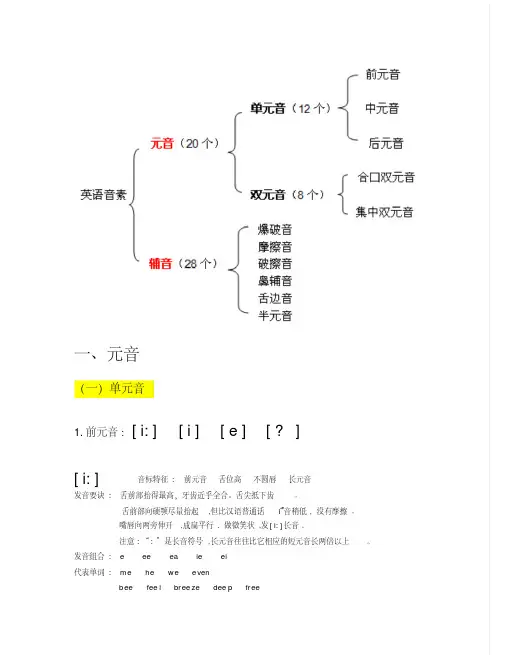
一、元音(一)单元音1.前元音:[ i: ] [ i ] [ e ] [ ? ][ i: ] 音标特征:前元音舌位高不圆唇长元音发音要诀:舌前部抬得最高,牙齿近乎全合。
舌尖抵下齿。
舌前部向硬颚尽量抬起,但比汉语普通话“i”音稍低, 没有摩擦。
嘴唇向两旁伸开,成扁平行. 做微笑状,发[ i: ]长音。
注意: “: ”是长音符号,长元音往往比它相应的短元音长两倍以上。
发音组合: e ee ea ie ei代表单词:me he w e evenbee fee l bree ze dee p fr eesea t bea t lea d tea ea t rea songrief bel ie ve ach ie verec eive conc eive[ i ] 音标特征: 前元音半高音扁平唇短元音发音要诀: 舌前部比[i:]稍低,比[e]高,舌尖抵下齿,嘴唇扁平分开。
牙床也开得稍大一些比[ i:]稍宽,比[ e ]窄。
上下齿之间的距离大约可以容纳一个小指尖。
使下颚稍稍下垂,舌前部也随之稍稍下降,即可发出短促[ i ]音。
发音组合: i代表单词: sit bit kick pick wish音标对比: [ i: ] [ i ]seat sitbeat bitsh ee p sh ip[ e ]音标特征:前元音半高音不圆唇短元音发音要诀:舌尖抵下齿, 舌前部稍抬起, 舌后接近硬颚, 比[ i:] 低。
牙床也开得半开半合,比[ i:] 宽,整体做微笑状。
上下齿之间的距离大约相当于一个食指尖。
发音组合: e ea a代表单词:pen ten best beg egg netbrea d heavenmarry any many音标对比:[ i ] [ e ]sit setlift leftdid dea d[?]音标特征: 前元音低舌音不圆唇短元音发音要诀: 舌前部最低,双唇向两旁平伸,成扁平行牙床开的最大。
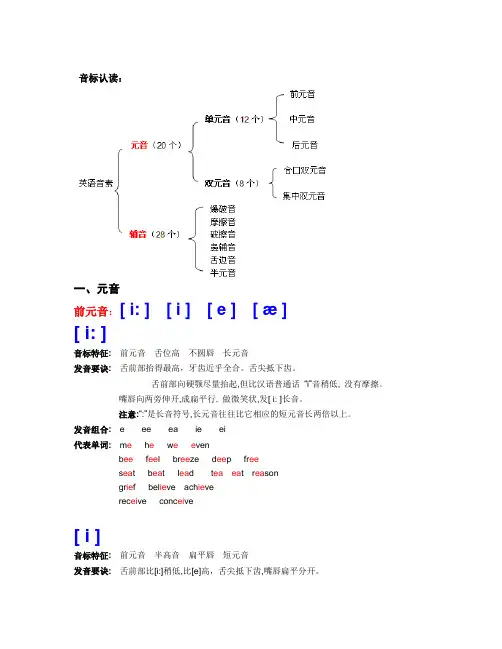
音标认读:一、元音前元音:[ i: ] [ i ] [ e ] [ æ ][ i: ]音标特征:前元音舌位高不圆唇长元音发音要诀:舌前部抬得最高,牙齿近乎全合。
舌尖抵下齿。
舌前部向硬颚尽量抬起,但比汉语普通话“i”音稍低, 没有摩擦。
嘴唇向两旁伸开,成扁平行. 做微笑状,发[ i: ]长音。
注意:“:”是长音符号,长元音往往比它相应的短元音长两倍以上。
发音组合: e ee ea ie ei代表单词:m e h e w e e venb ee f ee l br ee ze d ee p fr ees ea t b ea t l ea d t ea ea t r ea songr ie f bel ie ve ach ie verec ei ve conc ei ve[ i ]音标特征: 前元音半高音扁平唇短元音发音要诀: 舌前部比[i:]稍低,比[e]高,舌尖抵下齿,嘴唇扁平分开。
牙床也开得稍大一些比[ i:]稍宽,比[ e ]窄。
上下齿之间的距离大约可以容纳一个小指尖。
使下颚稍稍下垂,舌前部也随之稍稍下降,即可发出短促[ i ]音。
发音组合: i代表单词: s i t b i t k i ck p i ck w i sh音标对比: [ i: ] [ i ]s ea t s i tb ea t b i tsh ee p sh i p[ e ]音标特征:前元音半高音不圆唇短元音发音要诀:舌尖抵下齿, 舌前部稍抬起, 舌后接近硬颚, 比[ i:] 低。
牙床也开得半开半合,比[ i:] 宽,整体做微笑状。
上下齿之间的距离大约相当于一个食指尖。
发音组合: e ea a代表单词:p e n t e n b e st b e g e gg n e tbr ea d h ea venm a rry a ny m a ny音标对比:[ i ] [ e ]s i t s e tl i ft l e ftd i d d ea d[æ]音标特征: 前元音低舌音不圆唇短元音发音要诀: 舌前部最低,双唇向两旁平伸,成扁平行牙床开的最大。
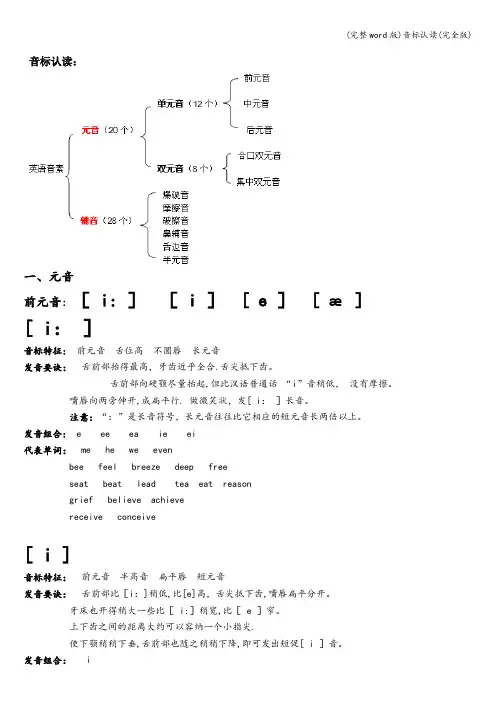
音标认读:一、元音前元音:[ i: ][ i ] [ e ] [ æ ] [ i:]音标特征:前元音舌位高不圆唇长元音发音要诀:舌前部抬得最高,牙齿近乎全合.舌尖抵下齿。
舌前部向硬颚尽量抬起,但比汉语普通话“i”音稍低,没有摩擦。
嘴唇向两旁伸开,成扁平行. 做微笑状,发[ i:]长音。
注意:“:”是长音符号,长元音往往比它相应的短元音长两倍以上。
发音组合: e ee ea ie ei代表单词: me he we evenbee feel breeze deep freeseat beat lead tea eat reasongrief believe achievereceive conceive[ i ]音标特征:前元音半高音扁平唇短元音发音要诀:舌前部比[i:]稍低,比[e]高,舌尖抵下齿,嘴唇扁平分开。
牙床也开得稍大一些比[ i:]稍宽,比[ e ]窄。
上下齿之间的距离大约可以容纳一个小指尖.使下颚稍稍下垂,舌前部也随之稍稍下降,即可发出短促[ i ]音。
发音组合: i代表单词: sit bit kick pick wish音标对比: [ i: ] [ i ]seat sitbeat bitsheep ship[ e ]音标特征:前元音半高音不圆唇短元音发音要诀:舌尖抵下齿,舌前部稍抬起, 舌后接近硬颚,比[ i:]低。
牙床也开得半开半合,比[ i:]宽,整体做微笑状.上下齿之间的距离大约相当于一个食指尖.发音组合: e ea a代表单词:pen ten best beg egg netbread heavenmarry any many音标对比: [ i ][ e ]sit setlift leftdid dead[æ]音标特征: 前元音低舌音不圆唇短元音发音要诀: 舌前部最低,双唇向两旁平伸,成扁平行牙床开的最大。
软颚升起,唇自然开放上下齿之间的距离大约相当于一个食指加中指.发音组合: a代表单词: cap map bad mad bank thank lamp音标对比:[e] [æ]beg bagmet matbed bad前元音小结:英语中有四个前元音,即:[ i:] [ i ] [ e ] [ æ ]发前元音时必须注意:1) 舌尖要抵住下齿。
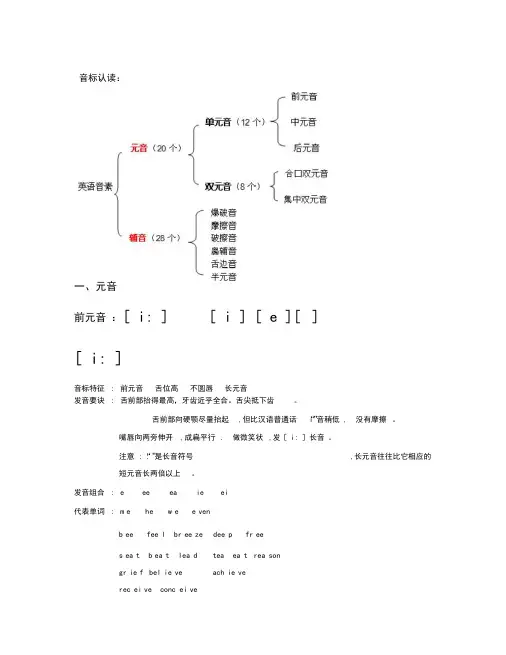
v1.0 可编辑可修改音标认读:一、元音前元音:[ i: ] [ i ] [ e ] [][ i: ]音标特征: 前元音舌位高不圆唇长元音发音要诀: 舌前部抬得最高,牙齿近乎全合。
舌尖抵下齿。
舌前部向硬颚尽量抬起,但比汉语普通话“i”音稍低 , 没有摩擦。
嘴唇向两旁伸开,成扁平行 . 做微笑状,发[ i: ] 长音。
注意 :“: ”是长音符号,长元音往往比它相应的短元音长两倍以上。
发音组合: e ee ea ie ei代表单词: m e he w e e venb ee fee l br ee ze dee p fr ees ea t b ea t lea d tea ea t rea songr ie f bel ie ve ach ie verec ei ve conc ei ve[ i ]音标特征: 前元音半高音扁平唇短元音发音要诀: 舌前部比[i:] 稍低 ,比[e] 高,舌尖抵下齿,嘴唇扁平分开。
v1.0 可编辑可修改牙床也开得稍大一些比[ i:] 稍宽 ,比[ e ] 窄。
上下齿之间的距离大约可以容纳一个小指尖。
使下颚稍稍下垂,舌前部也随之稍稍下降,即可发出短促 [ i ]音。
发音组合: i代表单词:s it b it ki p ick w ish音标对比:[ i: ][ i ]s ea t b ea t s it b itsh ee p sh ip[ e ]音标特征: 前元音半高音不圆唇短元音发音要诀: 舌尖抵下齿, 舌前部稍抬起,舌后接近硬颚, 比[ i:]低。
牙床也开得半开半合,比[ i:] 宽, 整体做微笑状。
上下齿之间的距离大约相当于一个食指尖。
发音组合: e ea a代表单词:pen ten b est b eg e gg net br ea d h ea venm a rry a ny ma ny音标对比:[ i ][ e ] s itset l iftle ftd id d ea d[ ]音标特征: 前元音低舌音不圆唇短元音发音要诀: 舌前部最低,双唇向两旁平伸,成扁平行牙床开的最大。
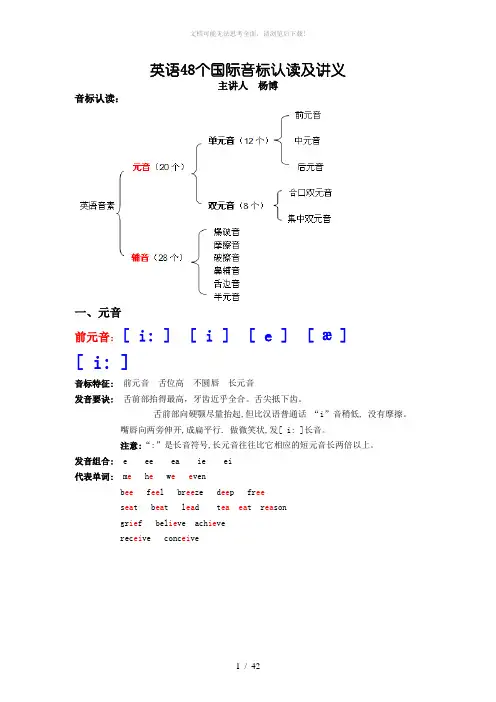
英语48个国际音标认读及讲义主讲人杨博音标认读:一、元音前元音:[ i: ] [ i ] [ e ] [ æ ][ i: ]音标特征:前元音舌位高不圆唇长元音发音要诀:舌前部抬得最高,牙齿近乎全合。
舌尖抵下齿。
舌前部向硬颚尽量抬起,但比汉语普通话“i”音稍低, 没有摩擦。
嘴唇向两旁伸开,成扁平行. 做微笑状,发[ i: ]长音。
注意:“:”是长音符号,长元音往往比它相应的短元音长两倍以上。
发音组合: e ee ea ie ei代表单词: m e h e w e e venb ee f ee l br ee ze d ee p fr ees ea t b ea t l ea d t ea ea t r ea songr ie f bel ie ve ach ie verec ei ve conc ei ve[ i ]音标特征: 前元音半高音扁平唇短元音发音要诀: 舌前部比[i:]稍低,比[e]高,舌尖抵下齿,嘴唇扁平分开。
牙床也开得稍大一些比[ i:]稍宽,比[ e ]窄。
上下齿之间的距离大约可以容纳一个小指尖。
使下颚稍稍下垂,舌前部也随之稍稍下降,即可发出短促[ i ]音。
发音组合: i代表单词: s i t b i t k i ck p i ck w i sh音标对比: [ i: ] [ i ]s ea t s i tb ea t b i tsh ee p sh i p[ e ]音标特征:前元音半高音不圆唇短元音发音要诀:舌尖抵下齿, 舌前部稍抬起, 舌后接近硬颚, 比[ i:] 低。
牙床也开得半开半合,比[ i:] 宽,整体做微笑状。
上下齿之间的距离大约相当于一个食指尖。
发音组合: e ea a代表单词:p e n t e n b e st b e g e gg n e tbr ea d h ea venm a rry a ny m a ny音标对比:[ i ] [ e ]s i t s e tl i ft l e ftd i d d ea d[æ]音标特征: 前元音低舌音不圆唇短元音发音要诀: 舌前部最低,双唇向两旁平伸,成扁平行牙床开的最大。
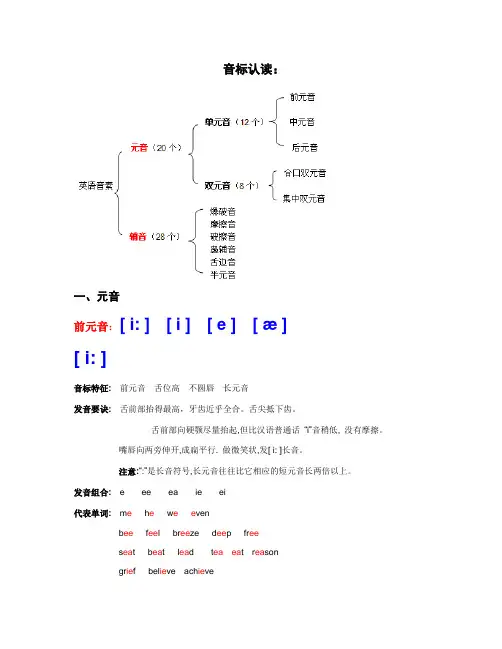
音标认读:一、元音前元音:[ i: ] [ i ] [ e ] [ æ ][ i: ]音标特征:前元音舌位高不圆唇长元音发音要诀:舌前部抬得最高,牙齿近乎全合。
舌尖抵下齿。
舌前部向硬颚尽量抬起,但比汉语普通话“i”音稍低, 没有摩擦。
嘴唇向两旁伸开,成扁平行. 做微笑状,发[ i: ]长音。
注意:“:”是长音符号,长元音往往比它相应的短元音长两倍以上。
发音组合: e ee ea ie ei代表单词:m e h e w e e venb ee f ee l br ee ze d ee p fr ees ea t b ea t l ea d t ea ea t r ea songr ie f bel ie ve ach ie verec ei ve conc ei ve[ i ]音标特征: 前元音半高音扁平唇短元音发音要诀: 舌前部比[i:]稍低,比[e]高,舌尖抵下齿,嘴唇扁平分开。
牙床也开得稍大一些比[ i:]稍宽,比[ e ]窄。
上下齿之间的距离大约可以容纳一个小指尖。
使下颚稍稍下垂,舌前部也随之稍稍下降,即可发出短促[ i ]音。
发音组合: i代表单词: s i t b i t k i ck p i ck w i sh音标对比: [ i: ] [ i ]s ea t s i tb ea t b i tsh ee p sh i p[ e ]音标特征:前元音半高音不圆唇短元音发音要诀:舌尖抵下齿, 舌前部稍抬起, 舌后接近硬颚, 比[ i:] 低。
牙床也开得半开半合,比[ i:] 宽,整体做微笑状。
上下齿之间的距离大约相当于一个食指尖。
发音组合: e ea a代表单词:p e n t e n b e st b e g e gg n e tbr ea d h ea venm a rry a ny m a ny音标对比:[ i ] [ e ]s i t s e tl i ft l e ftd i d d ea d[æ]音标特征: 前元音低舌音不圆唇短元音发音要诀: 舌前部最低,双唇向两旁平伸,成扁平行牙床开的最大。
![[VIP专享]48个国际音标认读详解(完全版-分类介绍)](https://uimg.taocdn.com/40d6486a0242a8956aece48a.webp)
一、元音(一)单元音1.前元音:[ i: ] [ i ] [ e ] [ æ ][ i: ] 音标特征:前元音舌位高不圆唇长元音发音要诀:舌前部抬得最高,牙齿近乎全合。
舌尖抵下齿。
舌前部向硬颚尽量抬起,但比汉语普通话“i”音稍低, 没有摩擦。
嘴唇向两旁伸开,成扁平行. 做微笑状,发[ i: ]长音。
注意: “: ”是长音符号,长元音往往比它相应的短元音长两倍以上。
发音组合: e ee ea ie ei代表单词:m e h e w e e venb ee f ee l br ee ze d ee p fr ees ea t b ea t l ea d t ea ea t r ea songr ie f bel ie ve ach ie verec ei ve conc ei ve[ i ] 音标特征: 前元音半高音扁平唇短元音发音要诀: 舌前部比[i:]稍低,比[e]高,舌尖抵下齿,嘴唇扁平分开。
牙床也开得稍大一些比[ i:]稍宽,比[ e ]窄。
上下齿之间的距离大约可以容纳一个小指尖。
使下颚稍稍下垂,舌前部也随之稍稍下降,即可发出短促[ i ]音。
发音组合: i代表单词: s i t b i t k i ck p i ck w i sh音标对比: [ i: ] [ i ]s ea t s i tb ea t b i tsh ee p sh i p[ e ]音标特征:前元音半高音不圆唇短元音发音要诀:舌尖抵下齿, 舌前部稍抬起, 舌后接近硬颚, 比[ i:] 低。
牙床也开得半开半合,比[ i:] 宽,整体做微笑状。
上下齿之间的距离大约相当于一个食指尖。
发音组合: e ea a代表单词:p e n t e n b e st b e g e gg n e tbr ea d h ea venm a rry a ny m a ny音标对比:[ i ] [ e ]s i t s e tl i ft l e ftd i d d ea d[æ]音标特征: 前元音低舌音不圆唇短元音发音要诀: 舌前部最低,双唇向两旁平伸,成扁平行牙床开的最大。
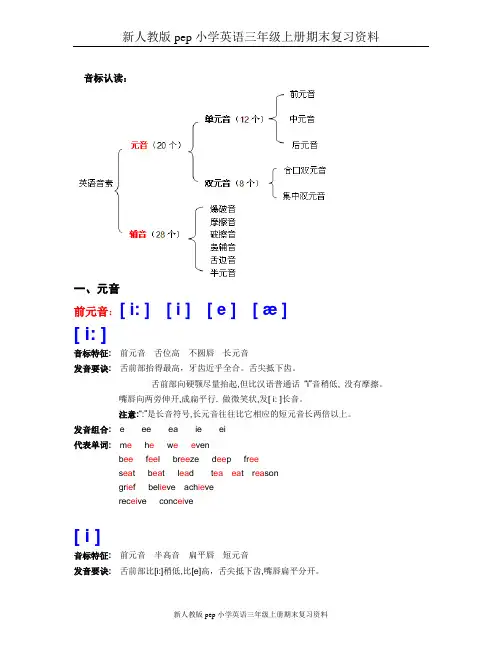
音标认读:一、元音前元音:[ i: ] [ i ] [ e ] [ æ ][ i: ]音标特征:前元音舌位高不圆唇长元音发音要诀:舌前部抬得最高,牙齿近乎全合。
舌尖抵下齿。
舌前部向硬颚尽量抬起,但比汉语普通话“i”音稍低, 没有摩擦。
嘴唇向两旁伸开,成扁平行. 做微笑状,发[ i: ]长音。
注意:“:”是长音符号,长元音往往比它相应的短元音长两倍以上。
发音组合: e ee ea ie ei代表单词:m e h e w e e venb ee f ee l br ee ze d ee p fr ees ea t b ea t l ea d t ea ea t r ea songr ie f bel ie ve ach ie verec ei ve conc ei ve[ i ]音标特征: 前元音半高音扁平唇短元音发音要诀: 舌前部比[i:]稍低,比[e]高,舌尖抵下齿,嘴唇扁平分开。
牙床也开得稍大一些比[ i:]稍宽,比[ e ]窄。
上下齿之间的距离大约可以容纳一个小指尖。
使下颚稍稍下垂,舌前部也随之稍稍下降,即可发出短促[ i ]音。
发音组合: i代表单词: s i t b i t k i ck p i ck w i sh音标对比: [ i: ] [ i ]s ea t s i tb ea t b i tsh ee p sh i p[ e ]音标特征:前元音半高音不圆唇短元音发音要诀:舌尖抵下齿, 舌前部稍抬起, 舌后接近硬颚, 比[ i:] 低。
牙床也开得半开半合,比[ i:] 宽,整体做微笑状。
上下齿之间的距离大约相当于一个食指尖。
发音组合: e ea a代表单词:p e n t e n b e st b e g e gg n e tbr ea d h ea venm a rry a ny m a ny音标对比:[ i ] [ e ]s i t s e tl i ft l e ftd i d d ea d[æ]音标特征: 前元音低舌音不圆唇短元音发音要诀: 舌前部最低,双唇向两旁平伸,成扁平行牙床开的最大。
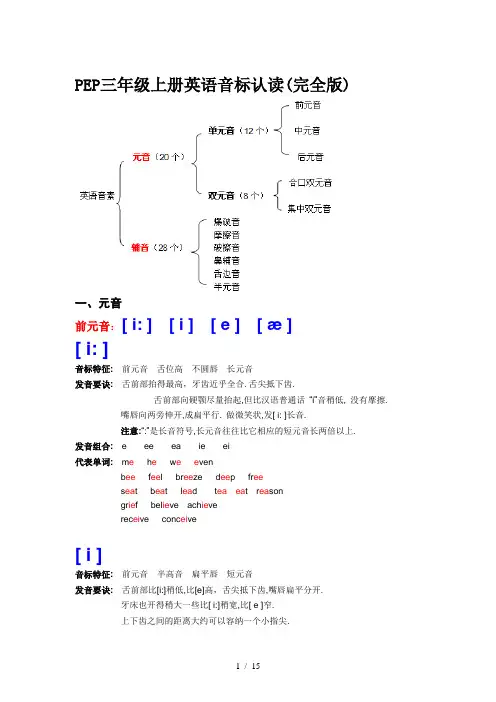
PEP三年级上册英语音标认读(完全版)一、元音前元音:[ i: ] [ i ] [ e ] [ æ ][ i: ]音标特征:前元音舌位高不圆唇长元音发音要诀:舌前部抬得最高,牙齿近乎全合.舌尖抵下齿.舌前部向硬颚尽量抬起,但比汉语普通话“i”音稍低, 没有摩擦.嘴唇向两旁伸开,成扁平行. 做微笑状,发[ i: ]长音.注意:“:”是长音符号,长元音往往比它相应的短元音长两倍以上.发音组合: e ee ea ie ei代表单词:m e h e w e e venb ee f ee l br ee ze d ee p fr ees ea t b ea t l ea d t ea ea t r ea songr ie f bel ie ve ach ie verec ei ve conc ei ve[ i ]音标特征: 前元音半高音扁平唇短元音发音要诀: 舌前部比[i:]稍低,比[e]高,舌尖抵下齿,嘴唇扁平分开.牙床也开得稍大一些比[ i:]稍宽,比[ e ]窄.上下齿之间的距离大约可以容纳一个小指尖.使下颚稍稍下垂,舌前部也随之稍稍下降,即可发出短促[ i ]音.发音组合: i代表单词: s i t b i t k i ck p i ck w i sh音标对比: [ i: ] [ i ]s ea t s i tb ea t b i tsh ee p sh i p[ e ]音标特征:前元音半高音不圆唇短元音发音要诀:舌尖抵下齿, 舌前部稍抬起, 舌后接近硬颚, 比[ i:] 低.牙床也开得半开半合,比[ i:] 宽,整体做微笑状.上下齿之间的距离大约相当于一个食指尖.发音组合: e ea a代表单词:p e n t e n b e st b e g e gg n e tbr ea d h ea venm a rry a ny m a ny音标对比:[ i ] [ e ]s i t s e tl i ft l e ftd i d d ea d[æ]音标特征: 前元音低舌音不圆唇短元音发音要诀: 舌前部最低,双唇向两旁平伸,成扁平行牙床开的最大.软颚升起, 唇自然开放上下齿之间的距离大约相当于一个食指加中指.发音组合: a代表单词: c a p m a p b a d m a d b a nk th a nk l a mp音标对比: [e] [æ]b e g b a gm e t m a tb e d b a d前元音小结:英语中有四个前元音,即:[ i: ] [ i ] [ e ] [ æ ]发前元音时必须注意:1) 舌尖要抵住下齿.2) 舌前部向硬颚部分抬起.3) 双唇不要收圆,发[ i: ] [ i ] [ e ] 时双唇平展,发[ æ ]时口形要张大,扁唇.4) 唇形舌位保持不变,否则就要发成双元音.中元音:[ə:] [ə]所谓中元音是指发音时要使用舌中部.也就是说舌中部要向硬腭抬起,舌尖要抵住上齿,口型圆.[ə: ]音标特征:中元音半高音不圆唇长元音发音要诀:舌身平放, 舌中部稍微抬起, 成自然状态,口半开半闭. 发长音[ : ].发音组合:or ir er ur ear代表单词:w or k w or ker w or mb ir d d ir t aff ir mt er mb ur n s ur fp ear l l ear n[ə ]音标特征:中元音半低音不圆唇短元音发音要诀:口半开半闭,牙床较张开,舌身平放,舌中部稍微抬起,成自然状态,这个音和汉语普通话轻声说“么”中的短促音“”相似,但英语的[ ]在词末时发音比普通话的“e”音长.发音组合:a er or代表单词:a ppear a rise a gain a like a man a penteach er moth er broth er driv er ang erdoct or act or tut or fam ou s jeal ou s音标对比:[ : ] [ ]ear th a rrivew or k tut or后元音: [a:] [ʌ] [u:][u][ɔ:][ɔ][a:]音标特征:后元音低音不圆唇长元音发音要诀:牙床大开,口张大,双唇张开而不圆.舌身平放舌尖后缩,舌后微升,舌身微离下齿.注意长度,不要发的太短.发音组合:ar ear al代表单词:f ar d ar k h ar t f ar m g ar den b ar st arh ear th al f[ʌ]音标特征:后元音半低音不圆唇短元音发音要诀:双唇平放,牙床半开,开口程度和[ æ ]相似,双唇向两旁平伸.舌后部的靠前部分稍稍抬起,舌尖和舌端两侧触下齿,舌尖抵住下牙龈,发短促音[ ].从短元音[ ]出发,将圆唇改为扁唇,即可发出[ ]音.发音组合:u o代表单词:u p c u t b u t b u s l u ck b u tterm o nk o nion音标对比:[a:] [ʌ]f a st f u nh ar t b u tc ard c u t[u:]音标特征:后元音高音圆唇长元音发音要诀:双唇成圆形,收得较[ ]更圆更小,双唇向前突出,牙床近于半合.舌后部比[ ]抬的更高,舌尖不触下齿,发长音[ ].注意长度,不要发的太短,口腔肌肉要始终保持紧张状态,自然而有力.发音组合:oo o ou u代表单词:f oo d f oo l b oo m c oo l h oo p p oo l sh oo tt o mbgr ou pbl ue cl ue r u le tr u th concl u de[u]音标特征:后元音高音圆唇短元音发音要诀:双唇成圆形,稍向前突出,牙床近于半合.舌尖不触下齿,舌后部向软颚抬起,舌身后缩.舌尖离开下齿自然而不用力,发短促音[ ].发音组合:oo u ou代表单词:f oo t g oo d c oo k h oo k t oo kp u ll f u ll b u llsh ou ld音标对比:[u:] [u]f oo t f oo db oo t b oo kc oo l c ou ldr oo f r oo mm oo n w oo d[ɔ:]音标特征:后元音半低音圆唇长元音发音要诀:双唇向外突出成圆形,稍稍收圆,介于开闭,圆唇之间.舌后升起,比[ ]略高,舌尖不触下齿.牙床半开渐至全开,舌尖卷上后在过渡微卷后.注意:双唇收得要更圆更小,并用力向前突出.注意长度,不要发得太短.发音组合:a oo aw ou ore au or ar代表单词:t a lk b a ll h a ll c a lld oo r fl oo rl aw s awb ou ght f ou ght th ou ght t ou ghtbef ore ign orec au ght n au ghty n au ticalf or ce b or n s o rtw ar n[ɔ]音标特征:后元音低音圆唇短元音发音要诀:口张大,舌身尽量降低并后缩.先发[ ]音,然后将舌身稍稍后缩,双唇稍稍收圆(不要突出),即可发[ ].发音组合:o代表单词:o x o n n o t c o p r o t h o t l o t音标对比:[ɔ:] [ɔ]s or t d o gt or t n o dsh or t sh o p后元音小结:英语中一共由六个后元音, 即: [ ] [ ] [ ] [ ] [ ] [ ] 发后元音时必须注意:1) 舌尖不触下齿, 舌身后缩, 舌后部向软颚部分抬起.2) 除了[ ] [ ], 其余都是圆唇音.3) 注意[ ] [ ] [ ]三个音的长度, 不要发的太短.双元音的一般特点是:1)由两个成分组成,发音时由一个元音向另一个元音滑动,发音过程口形有变化.2)前重后轻, 第一个成分发音响亮清澈, 第二个成分较轻弱模糊.3)前长后短, 第一个成分发音较长, 第二个成分发音较短.合口双元音为: [ei][ai][ɔɪ][au][əu][ei]发音要诀:舌尖抵住下齿,牙床半开半合.双唇扁平,口形由[ ]向[ ]滑动.发音过程中下颚向上合拢,舌位也随之稍稍抬高.发音组合:ei a ai ay代表单词:ei ghtc a ke f a te n a ked sn a ke l a ke m a ke n a mep ai d m ai nd ay m ay音标对比:[æ] [ei] [ e ]a t ei ghtb e db a t b a de s e tl a b l a te p e ns a nd s a me h e n[ai]发音要诀:将口张开略圆,舌后微升,舌尖向后收缩,由[ ]平稳过渡到[ ]音.开始部分[ ]是个前元音,和普通话“a”音相仿,但舌位更靠前,发音时舌尖必须抵住下齿.发音组合:y i uy代表单词:cr y dr y m yk i te h i gh b i ke t i ght f i ne t i meb uy g uy音标对比:[ æ ] [ai]b a t b i teb a ck b i ked a m cl i mbl a mp l i nes a ck s i gn[ɔɪ]发音要诀:双唇外突成圆形,发[ ]音,逐渐过渡为双唇扁平分开,发[ ]短音.注意:开始部分舌位在[ ] 和[ ]之间,由上述部分向 [ ]音滑动,由圆唇变成扁唇.发音组合:oy oi代表单词:t oy b oy l oy aln oi se v oi ce p oi nt s oi l c oi n oi l音标对比:[ɔɪ ] [ɔ]b oy b o sst oy t o psp oi l st o p[au]发音要诀:将口张开略圆,逐渐合拢,双唇逐渐成圆形,不要一开始就把双唇收圆.开始部分和[ ]中的[ ]音相同,由[ ]平稳过渡到[ ]音.滑动时双唇逐渐收成圆形,并把舌后部稍稍抬起.发音组合:ou ow代表单词:h ou se s ou nd ou t n ou nb ow t ow n n ow t ow er音标对比:[au] [ai]n ow n i ghtc ow k i tes ou nd s i de[əu]发音要诀:口半开半圆,舌后微微上升,过渡成双唇成圆形,发英语字母”O” 的长音.由[ ] 出发,然后把双唇收圆,滑向[ ].发音组合:o ow oa代表单词:h o st n o se t o ne h o le n o te c o ke c o peb ow l kn ow l ow ow nb oa tc oa t音标对比:[au] [əu]h ow h o lel ou d l oa d集中双元音为:[iə][ɛə][uə][iə]发音要诀:双唇张开,牙床由窄至半开,舌抵下齿逐渐过渡上卷,从[ ]音过渡到[ ]音.发[ ]时注意用扁平唇,嘴不要张得太大,以免发成[ æ ],[ ].发音组合:eer ear ere代表单词:b eer d eerh ear n ear f earh ere音标对比:[iə] [il]h ere h illf ear f eeld ear d eal[ɛə]发音要诀:双唇张开后略圆,牙床张开一定宽度,舌尖卷上慢慢卷后.发音组合:air ear are ere代表单词:h air f air air ch airb ear sw eard are h areth ere音标对比:[ɛə] [aiə]h air h iref are f iresp are sp ire[uə]发音要诀:双唇成圆形,牙床近于半合,舌尖不触下齿,由[ ]音很快向[ ]滑动.注意[ ] 不要发成[ ]音,或普通话的“u”.发音组合:oor ure our代表单词:p oorl ure s ureto ur音标对比:[uə] [əu]p oo r p o sts ur e s o ldl ur e l oa d二、辅音爆破音:[ p ] [ b ] [ t ] [ d ] [ k ] [ g ] [ p ]音标特征:双唇爆破清辅音发音要诀:双唇紧闭,然后突然放开, 使气流突破双唇外泄.[ p ]是清辅音发音时声带不震动.注意在[ s ] 音的后边, [ p ]音要读成相应的浊辅音 [ b ]发音组合:p代表单词:p ay p i p e p ut p ie p eachs p ort s p eed s p end[ b ]音标特征:双唇爆破浊辅音发音要诀:双唇紧闭,然后突然放开, 使气流突破双唇外泄.[ b ]是浊辅音发音时声带震动.发音组合:b代表单词:b ird b ed b ag b ig b uy b ake b ill b ear b ook音标对比:[ p ] [ b ]p ut b ookp en b edp et b etp ull b all[ t ]音标特征:舌尖齿龈爆破清辅音.发音要诀:双唇微开, 先用舌尖紧贴上齿龈, 形成阻碍, 然后突然下降,气流冲出口腔.[ t ]是清辅音,发音时声带不震动.注意在[ s ] 音的后边, [ t ]音要读成相应的浊辅音[ d ]发音组合:t代表单词:t ea t eacher t eam t are t ank t aught t ipi t mee t ca t though t fa t e t ent boa ts t udent s t and s t ick[ d ]音标特征:舌尖齿龈爆破浊辅音.发音要诀:双唇微开, 先用舌尖紧贴上齿龈, 形成阻碍, 然后突然下降,气流冲出口腔.[ d ]是浊辅音,发音时声带震动.发音组合:d代表单词:d o d i d d oes d eer d ate d ig d oomnee d be d climbe d音标对比:[ t ] [ d ]t ea d eedt eam d eepnea t nee dbe t be d[ k ]音标特征:舌后软颚爆破清辅音发音要诀:舌后部隆起, 舌根紧贴软颚, 形成阻碍, 然后突然张开,气流冲出口腔.声带不产生震动, 属于清辅音.在[ s ] 音后面读相应的浊辅音[ g ]发音组合:c k ck代表单词:c ake c ar c an c at c omek ite s k y k eeppic k bac k[ g ]音标特征:舌后软颚爆破浊辅音发音要诀:舌后部隆起, 舌根紧贴软颚, 形成阻碍,然后突然张开,气流冲出口腔.声带震动, 属于浊辅音.发音组合:g代表单词:g eese g o g ap g etbi g ba g be g音标对比:[ k ] [ g ]k eep g etk id g ainca k e be gpi ck pi gba k e bi g爆破音小结:1) [ p ] [ t ] [ k ] 是清辅音,发音时声带不震动,送气要强.在词末时不要加上元音[ ].2) [ b ] [ d ] [ g ] 是浊辅音,发音时声带必须震动.在词末时不要加上元音[ ].摩擦音:[ f ][ v ][ ][ ][ ][ ][ s ][ z ][ h ][ r ] [ f ]音标特征:唇齿摩擦清辅音发音要诀:上齿轻触下唇,用力将气流从唇齿之间吹出,引起摩擦成音.[ f ] 是清辅音,发音时声带不震动.发音组合:f ph代表单词:f ive f irst li f e f ine f at f ail f air f all f armtele ph one ph onetics ph oto[ v ]音标特征:唇齿摩擦浊辅音发音要诀:上齿轻触下唇,用力将气流从唇齿之间吹出,引起摩擦成音.[ v ] 是浊辅音,发音时声带震动.发音组合:v代表单词:v ote v i ne v at v ail v ery v aselea v e fi v e音标对比:[ f ] [ v ]li f e li v ef ive v oteph ysics v isit[θ]音标特征:舌尖齿背摩擦清辅音发音要诀:舌尖轻上齿背,气流由舌齿间窄缝泄出,摩擦成音.声带不震动,属于清辅音.发音组合:th代表单词:th ink tee th th ick th eme th ank th oughtbo th toot h tru th fif th mou th clo th fai th brea th[ð]音标特征:舌尖齿背摩擦浊辅音发音要诀:舌尖轻触上齿背,气流由舌齿间窄缝泄出,摩擦成音.声带震动,属于浊辅音.发音组合:th代表单词:th is th at th ese th ose th en th an th ough音标对比:[θ][ð]th ick th isth eme th antee th th eydea th th ese[ʃ]音标特征:舌端齿龈后部摩擦清辅音发音要诀:舌尖和舌端抬向上齿龈较后部分, 整个舌身抬起靠近上颚, 开成一条狭长的通道,用力将气息送出来.气流由此通道流过, 引起摩擦成音.双唇微开, 稍向前突出, 略成长方形, 注意不要扁唇, 以免发成汉语里的“徐”(太圆)和“希”(太扁)音.[ ]是清辅音, 发音时声带不震动.发音组合:sh s ss ch代表单词:sh ip fi sh sh eet sh eep di shs ure en s urea ss urema ch ine音标对比:[ʃ] [ f ]s ure f oursh ip f ishsh e f ee[3]音标特征:舌端齿龈后部摩擦浊辅音发音要诀:舌尖和舌端抬向上齿龈较后部分, 整个舌身抬起靠近上颚, 开成一条狭长的通道, 用力将气息送出来.气流由此通道流过, 引起摩擦成音.双唇微开, 稍向前突出, 略成长方形.[ ]是浊辅音, 发音时声带震动.发音组合:s代表单词:plea s ure u s ual lei s ure mea s ure音标对比:[3][ʃ]s ure trea s urema ch ine mea s urefini sh revi s ion[ s ]音标特征:舌端齿龈摩擦清辅音发音要诀:双唇微开,上下齿接近于合拢状态,舌端靠近齿龈(不要贴住),气流由齿龈之间泄出,摩擦成音.发音时声带不震动, 属于清辅音.发音组合:s c代表单词:s eem s et s eek s ay s eebook s den s e mou s e cup sfa c e i c e ra c e pri c e音标对比:[θ] [s]th eme s eemth ink s inkpa th pa ss[ z ]音标特征:舌端齿龈摩擦浊辅音发音要诀:双唇微开,上下齿接近于合拢状态,舌端靠近齿龈(不要贴住),气流由齿龈之间泄出,摩擦成音.声带震动,属于浊辅音.发音组合:z s代表单词:z oo pri z e z ealra is e knee s eye s音标对比:[ θ] [ z ] [ s ]th is z ip book sth ose z oo s eemwi th hi s advi c e[ h ]音标特征:声门摩擦辅音发音要诀:发这个音时气流从两条声带间的缝隙(声门)间通过,气流不受阻碍, 自由逸出口腔, 只在通过气门时发出轻微的摩擦.摩擦声门而成,但是声带不振动,是个清辅音,很像喘一口气,口形不定,随后面的元音而变化.注意: [ h ] 和汉语里的“h” 音的区别.汉语的“h”音比英语的[ h ]紧张有力.发英语时舌后部和软颚间不产生摩擦.发音组合:h wh 【注意】wh 在元音字母o前才发此音.代表单词:h ot h ome h ouse h orse h ate h ighwh ole wh o wh ose wh om[ r ]音标特征:舌尖齿龈后部摩擦辅音发音要诀:唇形稍圆,舌尖向上齿龈后部上卷,舌前部下陷,舌身略凹,舌身两侧收拢,发音时舌端抬起,向后面的硬颚弯曲,发生磨擦而成.要注意舌的动作是由前向后弯,声带振动,是个浊辅音.双唇略突出,气流由舌面与硬颚间泄出,震动声带.发音组合:r wr代表单词:r ace r ed r ice r ain r ight r oadf r ee f r y p r aywr ong wr ite摩擦音小结:英语中有十个摩擦音即: [ f ] [ v ][θ][ð] [ʃ] [3][ s ] [ z ] [ h ][ r ]发摩擦音时必须注意:1) 口腔通道不完全阻塞,留有窄小空隙, 气流从中泄出时摩擦或震动成音.2) 摩擦音可以延长而发音器官位置不变.破擦音:[t] [d][tr][dr][ts][dz][ t]音标特征:舌端齿龈破擦清辅音发音要诀:双唇微开, 舌尖舌端抬起, 先用舌尖抵上齿龈, 形成阻碍, 然后张开,使气流外泄而成音.气流冲破这个阻碍后, 舌和齿龈间仍保持一个狭缝,发出摩擦的声音.[ t]是清辅音, 发音时声带不震动.发音组合:ch代表单词:ch eap ch ild ch est c h oke ch eckcat ch wat ch音标对比:[ t] [ ]ch eap sh ipch ose sh oescat ch ca sh[d]音标特征:舌端齿龈破擦浊辅音发音要诀:双唇微开,舌尖舌端抬起,先用舌尖抵上齿龈,形成阻碍,然后张开,使气流外泄而成音.气流冲破这个阻碍后,舌和齿龈间仍保持一个狭缝,发出摩擦的声音.[ d]是浊辅音,发音时声带震动.发音组合:j g dg代表单词:j eep j oke j ew j uiceg in chan g ejo dg e ju dg e音标对比:[t] [d]ch arge ju dg ech oice j oinmat ch pa g e。
三年级英语上册音标认读(完全版)一、元音前元音:[ i: ] [ i ] [ e ] [ æ ][ i: ]音标特征:前元音舌位高不圆唇长元音发音要诀:舌前部抬得最高,牙齿近乎全合。
舌尖抵下齿。
舌前部向硬颚尽量抬起,但比汉语普通话“i”音稍低, 没有摩擦。
嘴唇向两旁伸开,成扁平行. 做微笑状,发[ i: ]长音。
注意:“:”是长音符号,长元音往往比它相应的短元音长两倍以上。
发音组合: e ee ea ie ei代表单词:m e h e w e e venb ee f ee l br ee ze d ee p fr ees ea t b ea t l ea d t ea ea t r ea songr ie f bel ie ve ach ie verec ei ve conc ei ve[ i ]音标特征: 前元音半高音扁平唇短元音发音要诀: 舌前部比[i:]稍低,比[e]高,舌尖抵下齿,嘴唇扁平分开。
牙床也开得稍大一些比[ i:]稍宽,比[ e ]窄。
上下齿之间的距离大约可以容纳一个小指尖。
使下颚稍稍下垂,舌前部也随之稍稍下降,即可发出短促[ i ]音。
发音组合: i代表单词: s i t b i t k i ck p i ck w i sh音标对比: [ i: ] [ i ]s ea t s i tb ea t b i tsh ee p sh i p[ e ]音标特征:前元音半高音不圆唇短元音发音要诀:舌尖抵下齿, 舌前部稍抬起, 舌后接近硬颚, 比[ i:] 低。
牙床也开得半开半合,比[ i:] 宽,整体做微笑状。
上下齿之间的距离大约相当于一个食指尖。
发音组合: e ea a代表单词:p e n t e n b e st b e g e gg n e tbr ea d h ea venm a rry a ny m a ny音标对比:[ i ] [ e ]s i t s e tl i ft l e ftd i d d ea d[æ]音标特征: 前元音低舌音不圆唇短元音发音要诀: 舌前部最低,双唇向两旁平伸,成扁平行牙床开的最大。
音标认读:一、元音前元音:[ i: ] [ i ] [ e ] [ æ ][ i: ]音标特征:前元音舌位高不圆唇长元音发音要诀:舌前部抬得最高,牙齿近乎全合。
舌尖抵下齿。
舌前部向硬颚尽量抬起,但比汉语普通话“i”音稍低, 没有摩擦。
嘴唇向两旁伸开,成扁平行. 做微笑状,发[ i: ]长音。
注意:“:”是长音符号,长元音往往比它相应的短元音长两倍以上。
发音组合: e ee ea ie ei代表单词:m e h e w e e venb ee f ee l br ee ze d ee p fr ees ea t b ea t l ea d t ea ea t r ea songr ie f bel ie ve ach ie verec ei ve conc ei ve[ i ]音标特征: 前元音半高音扁平唇短元音发音要诀: 舌前部比[i:]稍低,比[e]高,舌尖抵下齿,嘴唇扁平分开。
牙床也开得稍大一些比[ i:]稍宽,比[ e ]窄。
上下齿之间的距离大约可以容纳一个小指尖。
使下颚稍稍下垂,舌前部也随之稍稍下降,即可发出短促[ i ]音。
发音组合: i代表单词: s i t b i t k i ck p i ck w i sh音标对比: [ i: ] [ i ]s ea t s i tb ea t b i tsh ee p sh i p[ e ]音标特征:前元音半高音不圆唇短元音发音要诀:舌尖抵下齿, 舌前部稍抬起, 舌后接近硬颚, 比[ i:] 低。
牙床也开得半开半合,比[ i:] 宽,整体做微笑状。
上下齿之间的距离大约相当于一个食指尖。
发音组合: e ea a代表单词:p e n t e n b e st b e g e gg n e tbr ea d h ea venm a rry a ny m a ny音标对比:[ i ] [ e ]s i t s e tl i ft l e ftd i d d ea d[æ]音标特征: 前元音低舌音不圆唇短元音发音要诀: 舌前部最低,双唇向两旁平伸,成扁平行牙床开的最大。
音标认读(完全版)元音发音组合[iː]该发音组合代表单词包括me。
he。
we。
even。
beef。
feel。
breeze。
deep。
free。
seat。
beat。
lead。
tea。
eat。
reason。
grief。
believe。
achieve。
receive。
和 conceive。
发音组合 [i]发出短促的 [i] 音需要使下颚稍稍下垂,舌前部也随之稍稍下降。
该发音组合代表单词包括 sit。
bit。
kick。
pick。
和wish。
音标对比:[iː] 和 [i]座位和坐下、节拍和小块、绵羊和船只。
发音组合 [e]该发音组合代表单词包括pen。
ten。
best。
beg。
egg。
net。
bread。
heaven。
marry。
any。
many。
音标对比:[i] 和 [e]坐和设、举起和左边、做和死亡。
发音组合 [æ]该发音组合代表单词包括 cap。
map。
bad。
mad。
bank。
thank。
和 lamp。
音标对比:[e] 和 [æ]乞讨和背包、会议和猎人、床和坏。
发音组合 [əː]该发音组合代表单词包括 work。
worker。
worm。
bird。
dirt。
affirm。
term。
burn。
和 pearl。
发音组合 [ə]该发音组合代表单词包括 appear。
arise。
again。
alike。
man。
ape。
pen。
teacher。
mother。
brother。
driver。
anger。
doctor。
actor。
tutor。
famous。
和 jealous。
发音组合[aː]该发音组合代表单词包括far。
dark。
hart。
farm。
garden。
bar。
star。
和 half。
发音组合 [ʌ]该发音组合代表单词包括 up。
cut。
but。
bus。
luck。
butter。
monk。
和 n。
音标对比:[aː] 和 [ʌ]快速和有趣、心脏和但是。
发音组合[uː]该发音组合代表单词包括foot。
英语48个音标认读音标认读:一、元音前元音:[ i: ] [ i ] [ e ] [ æ][ i:]音标特征:前元音舌位高不圆唇长元音发音组合: e ee ea ie ei代表单词: m e h e w e e venb ee fe e l br ee ze d ee p fr ees ea t b ea t l ea d t ea ea t r ea songr ie f bel ie ve ach ie verec ei ve conc ei ve[ i ]音标特征: 前元音半高音扁平唇短元音发音组合: i代表单词: sit bit kick pick wish音标对比: [ i: ] [ i ]seat sitbeat bitsheep ship[ e ]音标特征:前元音半高音不圆唇短元音发音组合: e ea a代表单词:pen ten best beg egg netbread heavenmarry any many音标对比:[ i ] [ e ]sit setlift leftdid dead[ æ]音标特征: 前元音低舌音不圆唇短元音发音组合: a代表单词: cap map bad mad bank thank lamp音标对比: [e] [æ]beg bagmet matbed bad前元音小结:英语中有四个前元音,即:[ i:][ i ] [ e ][æ ]中元音:[ə:] [ə]所谓中元音是指发音时要使用舌中部。
也就是说舌中部要向硬腭抬起,舌尖要抵住上齿,口型圆。
[ ə: ]音标特征:中元音半高音不圆唇长元音发音组合:or ir er ur ear代表单词:work worker wormbird dirt affirmtermburn surfpearl learn[ə ]音标特征:中元音半低音不圆唇短元音发音组合:a er or代表单词:appear arise again alike a man a penteacher mother brother driver angerdoctor actor tutor famous jealous音标对比:[ə: ] [ə ]earth arrivework tutor后元音: [a:] [ʌ][u:][u] [ɔ:] [ɔ] [ a: ]音标特征:后元音低音不圆唇长元音发音组合:ar ear al代表单词:far dark hart farm garden bar star hearthalf calm palm[ ʌ ]音标特征:后元音半低音不圆唇短元音发音组合:u o代表单词:up cut but bus luck buttermonk onion音标对比:[a:] [ʌ]fast funhart butcard cut[u:]音标特征:后元音高音圆唇长元音发音组合:oo o ou u代表单词:food fool boom cool hoop pool shoot tombgroupblue clue rule truth conclude[ u ]音标特征:后元音高音圆唇短元音发音组合:oo u ou代表单词:foot good cook hook tookpull full bull should音标对比:[u:] [u]foot foodboot bookcool couldroof roommoon wood[ ɔ: ]音标特征:后元音半低音圆唇长元音发音组合:a oo aw ou ore au or ar代表单词:talk ball hall calldoor floorlaw sawbought fought thought toughtbefore ignorecaught naughty nauticalforce born sortwarn[ɔ]音标特征:后元音低音圆唇短元音发音组合:o代表单词:ox on not cop rot hot lot音标对比:[ɔ:] [ɔ]sort dogtort nodshort shop后元音小结:英语中一共由六个后元音,即: [a:] [ʌ] [u:] [u][ɔ:] [ɔ]双元音的一般特点是:1)由两个成分组成,发音时由一个元音向另一个元音滑动,发音过程口形有变化. 2)前重后轻, 第一个成分发音响亮清澈,第二个成分较轻弱模糊。
音标认读:一、元音前元音:[ i: ] [ i ] [ e ] [ æ ][ i: ]音标特征:前元音舌位高不圆唇长元音发音要诀:舌前部抬得最高,牙齿近乎全合。
舌尖抵下齿。
舌前部向硬颚尽量抬起,但比汉语普通话“i”音稍低, 没有摩擦。
嘴唇向两旁伸开,成扁平行. 做微笑状,发[ i: ]长音。
注意:“:”是长音符号,长元音往往比它相应的短元音长两倍以上。
发音组合: e ee ea ie ei代表单词:m e h e w e e venb ee f ee l br ee ze d ee p fr ees ea t b ea t l ea d t ea ea t r ea songr ie f bel ie ve ach ie verec ei ve conc ei ve[ i ]音标特征: 前元音半高音扁平唇短元音发音要诀: 舌前部比[i:]稍低,比[e]高,舌尖抵下齿,嘴唇扁平分开。
牙床也开得稍大一些比[ i:]稍宽,比[ e ]窄。
上下齿之间的距离大约可以容纳一个小指尖。
使下颚稍稍下垂,舌前部也随之稍稍下降,即可发出短促[ i ]音。
发音组合: i代表单词: s i t b i t k i ck p i ck w i sh音标对比: [ i: ] [ i ]s ea t s i tb ea t b i tsh ee p sh i p[ e ]音标特征:前元音半高音不圆唇短元音发音要诀:舌尖抵下齿, 舌前部稍抬起, 舌后接近硬颚, 比[ i:] 低。
牙床也开得半开半合,比[ i:] 宽,整体做微笑状。
上下齿之间的距离大约相当于一个食指尖。
发音组合: e ea a代表单词:p e n t e n b e st b e g e gg n e tbr ea d h ea venm a rry a ny m a ny音标对比:[ i ] [ e ]s i t s e tl i ft l e ftd i d d ea d[æ]音标特征: 前元音低舌音不圆唇短元音发音要诀: 舌前部最低,双唇向两旁平伸,成扁平行牙床开的最大。
音标认读一、元音前元音:[ i: ] [ i ] [ e ] [ æ ][ i: ]发音组合: e ee ea ie ei代表单词:me he we even bee feel breeze deep freeseat beat lead tea eat reason grief believe achieve receive [ i ]发音组合: i代表单词: sit bit kick pick wish音标对比: [ i: ] [ i ]seat sitbeat bitsheep ship[ e ]发音组合: e ea a代表单词:pen ten best beg egg net bread heaven marry any many音标对比:[ i ] [ e ]sit setlift leftdid dead[æ]发音组合: a代表单词: cap map bad mad bank thank lamp音标对比: [e] [æ]beg bagmet matbed bad中元音:[ə:] [ə][ə: ]发音组合:or ir er ur ear代表单词:work worker worm bird dirt affirm term burn surf pearl learn [ə ]发音组合:a er or代表单词:a ppear a rise a gain a like a man a penteach er moth er broth er driv er ang erdoct or act or tut or fam ou s jeal ou s音标对比:[ə: ][ə ]earth arrivework tutor后元音: [a:] [ʌ] [u:][u][ɔ:][ɔ][a:]发音组合:ar ear al代表单词:far dark hart farm garden bar star heart half[ʌ]发音组合:u o代表单词:up cut but bus luck butter monk onion音标对比:[a:] [ʌ]fast funhart butcard cut[u:]音标特征:后元音高音圆唇长元音发音组合:oo o ou u代表单词:food fool boom cool hoop pool shoot tomb group blue clue rule truth conclude [u]发音组合:oo u ou代表单词:foot good cook hook took pull full bull should音标对比:[u:] [u]foot foodboot bookcool couldroof roommoon wood[ɔ:]发音组合:a oo aw ou ore au or ar代表单词:talk ball hall call door floor law saw bought fought thought before ignore caught naughty nautical force born sort warn[ɔ]发音组合:o代表单词:ox on not cop rot hot lot音标对比:[ɔ:] [ɔ]sort dogtort nodshort shop合口双元音为: [ei][ai][ɔɪ][au][əu][ei]发音组合:ei a ai ay代表单词:eight cake fate naked snake lake make name paid main day may 音标对比:[æ] [ei] [ e ]at eight bedbat bade setlab late pensand same hen[ai]发音组合:y i uy代表单词:cry dry my kite high bike tight fine time buy guy音标对比:[ æ ] [ai]bat biteback bikedam climblamp linesack sign[ɔɪ]发音组合:oy oi代表单词:toy boy loyal noise voice point soil coin oil音标对比:[ɔɪ ] [ɔ]boy bosstoy topspoil stop[au]发音组合:ou ow代表单词:house sound out noun bow town now tower音标对比:[au] [ai]now nightcow kitesound side[əu]发音组合:o ow oa代表单词:host nose tone hole note coke cope bowl know low own boat coat 音标对比:[au] [əu]how holeloud load集中双元音为:[iə][ɛə][uə][iə]发音组合:eer ear ere代表单词:beer deer hear near fear here音标对比:[iə] [il]here hillfear feeldear deal[ɛə]发音组合:air ear are ere代表单词:hair fair air chair bear swear dare hare there音标对比:[ɛə] [aiə]hair hirefare firespare spire[uə]发音组合:oor ure our代表单词:poor lure sure tour音标对比:[uə] [əu]poor postsure soldlure load二、辅音爆破音: [ p ] [ b ] [ t ] [ d ] [ k ] [ g ][ p ]发音组合:p代表单词:pay pipe put pie peach sport speed spend[ b ]发音组合:b代表单词:bird bed bag big buy bake bill bear book音标对比:[ p ] [ b ]put bookpen bedpet betpull ball[ t ]发音组合:t代表单词:tea teacher team tare tank taught tip it meet cat thought fate tent boat student stand stick[ d ]发音组合:d代表单词:do did does deer date dig doom need bed climbed音标对比:[ t ] [ d ]tea deedteam deepneat needbet bed[ k ]发音组合:c k ck代表单词:cake car can cat come kite sky keep pick back[ g ]发音组合:g代表单词:geese go gap get big bag beg音标对比:[ k ] [ g ]keep getkid gaincake begpick pigbake big摩擦音: [ f ] [ v ] [θ] [ð] [ʃ][3] [ s ] [ z ] [ h ] [ r ] [ f ]发音组合:f ph代表单词:five first life fine fat fail fair fall farm telephone phonetics photo [ v ]发音组合:v代表单词:vote vine vat vail very vase leave five音标对比:[ f ] [ v ]life livefive votephysics visit[θ]发音组合:th代表单词:think teeth thick theme thank thought both tooth truth fifth mouth cloth faith breath[ð]发音组合:th代表单词:this that these those then than though音标对比:[θ][ð]thick thistheme thanteeth theydeath these[ʃ]发音组合:sh s ss ch代表单词:ship fish sheet sheep dish sure ensure assure machine音标对比:[ʃ] [ f ]sure fourship fishshe fee[ʒ]发音组合:s代表单词:pleasure usual leisure measure音标对比:[3][ʃ]sure treasuremachine measurefinish revision[ s ]发音组合:s c代表单词:seem set seek say see books mouse cups face ice race price 音标对比:[θ] [s]theme seemthink sinkpath pass[ z ]发音组合:z s代表单词:zoo prize zeal raise knees eyes音标对比:[ ] [ z ] [ s ]this zip booksthose zoo seemwith his advice[ h ]发音组合:h wh代表单词:hot home house horse hate high whole who whose whom[ r ]发音组合:r wr代表单词:race red rice rain right road free fry pray wrong write破擦音: [tʃ][dʒ] [tr][dr] [ts][dz]发音组合:ch代表单词:cheap child chest choke check catch watch 音标对比:[ tʃ] [ʃ]cheap shipchose shoescatch cash[dʒ]发音组合:j g dg代表单词:jeep joke jew juice gin change judge音标对比:[tʃ] [dʒ]charge judgechoice joinmatch page[tr]发音组合:tr代表单词:tree treat trip train tram[dr]发音组合:dr代表单词:dream drag draw drink children音标对比: [ tr ] [ dr ]tree dreamtry drytreat dream[ ts ]发音组合:ts代表单词:sits seats mates peasants parents音标对比:[ ts ] [ s ]gets guesslets lesslots lossplants class发音组合:ds代表单词:needs seeds spends音标对比:[ts] [ dz ] [ z ] [ dz ]bets beds boys boardsseats seeds gloves groundsnets needs stares stands鼻辅音: [ m ] [ n ] [ ŋ ][ m ]发音组合:m代表单词:some come dime mother map moon[ n ]发音组合:n代表单词:n oon n ose n ote n ot n o n othing moo n soo n so n gu n thi n ru n [ŋ]发音组合:ng n代表单词:sing song singer king thing ink sink thank tank音标对比:[ m ] [ n ]home stonetheme thinment net舌边音: [ l ]发音组合: l代表单词:清晰音[ l ] let lad late laid leap lap代表单词:含糊音[ l ] deal tell belt sale table半元音: [ w ][ j ][ w ]发音组合:w wh代表单词:wait west way wet will wide wheel what why when where while音标对比:[ w ] [ v ]wet vetwinter inventionworld voicewomen visit[ j ]发音组合:y代表单词:year yes yet yard young you音标对比:[ i: ] [ j ]eat yeteast yeseager yard英语音标发音表英语国际音标共48个音素,其中元音音素20个,辅音音素28个。